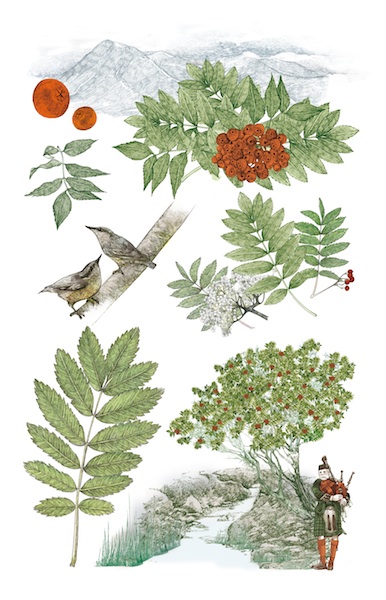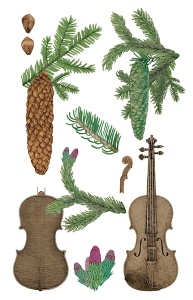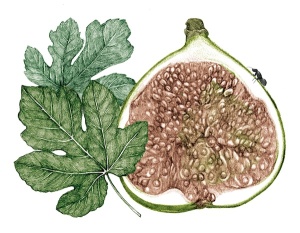Around the world in 80 trees
by Jonathan Drori and Lucille Clerc
“Nature writing at its best, skilfully weaving science with fascinating folklore and the sheer wonder of trees.” Prof. Sir Charles Godfray FRS
Trees are one of humanity’s most constant and most varied companions. From India’s sacred banyan tree to the fragrant cedar of Lebanon, they offer us sanctuary and inspiration – as well as raw materials for everything from aspirin to maple syrup. In Around the World in 80 Trees, Jonathan Drori uses plant science and natural history to illuminate how trees play a role in every part of human life, from the romantic to the regrettable, together with captivating illustrations by Lucille Clerc. Here’s a taster.
click on any image to enlarge
and view in slideshow
Strawberry Tree (Arbutus unedo), Ireland
The strawberry tree is native to the western Mediterranean and the southwest of Ireland – but not Britain. Whether by accident or design, Neolithic sailors are thought to have brought the species with them from the Iberian Peninsula some time between 10000 and 3000 BC.
Rowan (Sorbus aucuparia), Scotland
The rowan is a small, hardy deciduous tree, very much at home in the windy Scottish highlands. Its clusters of pretty cream flowers have a strong scent and plenty of nectar to attract hordes of pollinating insects. In bad weather, when insects are scarce, the flowers can self-pollinate.
Silver Birch (Betula pendula), Finland
By day, the distinctive monochrome pattern of snow-clad birch forests is dazzling and disorientating, but during long boreal nights, their moonlit, ghostly forms take on an eerie power. Birches abound in the folk tales, superstitions and rituals of northern peoples.
Lime Tree, Linden (Tilia x europaea), Germany
Linden trees are associated with Freya, the Germanic goddess of love, spring and fertility. Proust played on this in À la recherche du temps perdu, in which the narrator dips a madeleine cake into lime-blossom tea, triggering a chain of involuntary memories.
Argan (Argania spinosa), Morocco
Nimble goats have learned to avoid the thorns and leathery leaves of the argan to gorge on its sweet-smelling fruit. The oil-rich seeds are the mainstay of the local economy. The oil is used locally to treat skin diseases and heart ailments, and is fashionable in wealthy nations as a salad oil and in hair products and anti-wrinkle creams.
Norway Spruce (Picea abies), Italy
The classic Christmas tree is also prized for its ‘tonewood’, which is used to make the soundboards of the world’s most valuable stringed instruments. Stiff materials make the best soundboards because they can transmit vibration efficiently from molecule to molecule; in a more elastic material, energy is squandered as the sound waves travel through it.
Fig (Ficus carica), Turkey
The Blastophaga wasps that pollinate the common edible fig are female, stingless and just a couple of millimetres long. Wasps of both genders hatch inside the fruit. After mating, the male will burrow his way out and die. After a brief rest, the female also exits, dousing herself in pollen produced by male flowers as she goes. After laying her eggs in the next fig she is doomed, as enzymes in the plant gradually digest her.
Date Palm (Phoenix dactylifera), Egypt
The edible date originated somewhere between northeast Africa and Mesopotamia and may have been cultivated in the Middle East for six millennia. An iconic fruit in all the cultures of the region and a staple food containing up to two-thirds sugar, the date has altered the course of history by enabling large numbers of people to live in deserts.
Chinese Lacquer (Toxicodendron vernicifluum), Japan
True to its scientific name, the lacquer tree has an unpleasant side. An oily substance in its sap, called urushiol (from the Japanese word urushi, varnish), is a particularly nasty chemical also present in poison ivy. Liquid urushiol causes extreme rashes, and even its vapour promotes itching that can linger for months. Once hardened, however, lacquerware is safe for storing foodstuffs.
Durian (Durio zibethinus), Malaysia
In a confined space the smell of the durian fruit can be overwhelming, and signs telling people not to bring durians into hotels or aircraft are common in Malaysia and Singapore. The English writer Anthony Burgess likened the taste to “eating sweet raspberry blancmange in the lavatory”, and American chef Anthony Bourdain said “Your breath will smell as if you’d been French-kissing your dead grandmother.”
Jonathan Drori is a Trustee of The Woodland Trust and The Eden Project, an Ambassador for the WWF and was for nine years a Trustee of the Royal Botanic Gardens, Kew. He is a Fellow of the Linnean Society and the Zoological Society of London, and a Member of the Institution of Engineering and Technology. He was made CBE in 2006.
@jondrori
Lucille Clerc is a French illustrator and graphic designer based in London, who works with a diverse range of international clients including cultural institutions, textile designers, musicians and architects.
lucilleclerc.com
@LucilleClerc
Around the World in 80 Trees in published in hardback by Laurence King (£17.99).
Read more











